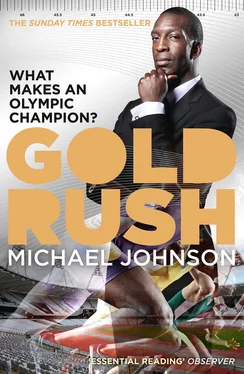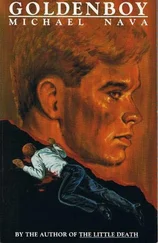TRYING TO MAKE HISTORY
After a day of rest, I awoke really early because I had a morning start time for the first round of the 200 metres. I liked morning start times because I didn’t have to wait around all day. The quarter-finals would be later that evening. I also liked the idea of getting two races done in one day. Both races went very smoothly. As always, I used them to work on my start and the first 60 metres of the race, during which I tried to make up the stagger on each of the athletes outside of me as quickly as possible as we went around the curve.
The following evening, after winning both rounds the day before, it was time to run the semi-final and final. Normally the semi-final is held in the morning or early afternoon and the final much later in the evening. Instead, we would have less than two hours between the races. Regardless, this would be the day when I would either succeed or fail at what I had set out to do.
The short interval between the races challenged all the competitors in terms of what kind of warm-up to do. On our way out to the warm-up track to get ready for the semi-final, Coach said that he had thought a lot about it and decided it would be best if we went back over to the warm-up track after the semi-final, rest for half an hour, then do a modified warm-up of about 50 per cent of what we would normally do. He felt that in view of this awkward and unfamiliar situation it would be best to stick to our pre-race routine as much as possible. The last thing we wanted during the biggest event of our lives was to create a new pre-race routine even in the face of such unusual circumstances. The decision was a brilliant coaching move.
The semi-final went well. When I came out of the curve far ahead, I decided to slow down and conserve my energy for the final. With 75 metres to go in the semi-final of the Olympics, I was so far ahead I could have stopped running and still win. So that’s exactly what I did.
Before the final, I lay on my massage therapist’s table for half an hour, running the race over and over and over in my mind. Coach went to see how the lanes had been allocated. Upon his return I tried to ascertain from his face what lane I had drawn. The preference was lane four or five. Coach didn’t show any emotion. I think he didn’t really care which lane I got because he knew I could win from any lane, but I was intent on running the fastest possible time and wanted every advantage I could get.
Since the 200 is such a short race, I wasn’t as concerned about making an error as I had been in the 400. My main concern was trying to run as fast as I possibly could. Lane five, with its gentler curve than three or four, would be perfect. In addition, it would give me the opportunity to have at least one of the faster qualifiers outside of me in lane six as a rabbit. Instead of lane five, however, I drew lane three. Not ideal, but not as bad as it could have been. Besides, Frankie Fredericks from Namibia, a friend and someone for whom I have tremendous respect, Ato Boldon from Trinidad, and the Cuban Ivan Garcia, who was an incredibly quick starter, would all be in the lanes outside of me. That meant three good rabbits!
I put on my headphones, which I always used when I first arrived at the warm-up track to help me get into my own zone and focus, and to minimise distractions. Although I have always enjoyed a wide range of music from jazz to rap, 2Pac was one of my favourite artists. For the 400, I would always listen to some up-tempo R&B; Dangelo was a favourite. But for the 200 I liked to get into a more forceful mode, so I had a playlist of rap music to match the more aggressive approach needed for the 200 metres. For this race, I chose 2 Pac’s ‘Me Against the World’.
Coach walked over. ‘It’s time,’ he said. I already knew that; I had been looking at my watch every couple of minutes, waiting impatiently for that 30-minute pre-race period to be over so I could start moving again and getting ready. I started to do a modified warm-up which went really well. Then we got back on the bus.
Coach was really serious. I knew he was nervous because he had walked around the warm-up track for almost the entire 30 minutes while I was resting, which was always his tell. He didn’t say anything on the bus back to the Olympic stadium; neither did I. With my headphones back on I started to listen to 2Pac again. Same song – ‘Me Against the World’. The tempo was slower than I wanted, but it was saying all the right things. I did feel it was me against the world. Everyone else in the race – and in any race I was in – could make their careers from beating me. I couldn’t blame them for gunning for me. That’s what they were supposed to do.
‘Watch your start,’ Coach said when we got off the bus, reminding me not to pop straight up out of the blocks, which I tend to do as a result of my naturally more upright running style. Then he just said, ‘Go get ’em.’
In the warm-up area under the stadium where the other athletes waited, I checked in again with the officials, then sat in a corner by myself just running the race over and over again in my mind. I started to think about the camera flashes that would accompany my eighth entry into the stadium that week. I had been told that the flashes actually followed me around the stadium as I ran. That then led me to think about how big this would be if I was successful.
I knew what the next thought would be. How big this would be if I failed. Competing in athletics at the Olympic level is probably more difficult from a pressure standpoint than any other sport. With the Games taking place only every four years, the average Olympic athlete might make two Olympic teams in his career. So he has to go into an Olympics knowing that this could be a once-in-a-lifetime opportunity – he may never get another. To compound that sense of pressure, the athlete also knows that it is the biggest crowd he will ever compete in front of, and that the focus at home is on him. Everyone in his country is watching him and wanting him to win. This is not just any other competition.
So then how do you approach it from a mental standpoint? You know that it is special and the history and the magnitude of the Olympics can’t be ignored. But if you are to have your best performance, the type of performances you have had to get to this point, you must compete the way you competed in those competitions. So as an athlete you must strike a balance: on the one hand understanding the special nature of this competition and the rarity of the opportunity, on the other preparing and competing the same way you would in any other competition. That’s not easy to do, and it takes tremendous mental toughness to strike that balance and to resist the natural temptation to compete harder when the stakes are higher and the opportunity is greater. Competing harder can be dangerous. You can now run tight or overdo the preparation or the execution.
I was certainly at risk in that way. Having just completed four rounds of 400-metre races, including the final just two days before the start of the 200 metres, I was now about to run my eighth race of the Games. Certainly fatigue would have started to set in. I had known all along throughout my preparation and training for this task that it would be difficult and I would have to run a mistake-free race because so much was at stake. But even thinking about the stakes could easily stymie my ability to execute.
I immediately started running the race in my mind again. I knew that when I needed to be focused it wasn’t enough to tell myself not to think about things that didn’t matter or that were a distraction from the task immediately ahead. That didn’t work. I had to, first, recognise immediately when I was becoming distracted, and then replace that thought with something else. And the best something else was always the task at hand. So I always started with the bang of the gun and me reacting to it, and then visualised, step by step, myself executing the race to perfection.
Читать дальше












